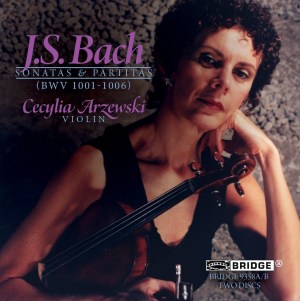 |
 |
|

|
Support
us financially by purchasing this disc from:
|
|
|
|
|
|
|
|
Johann Sebastian BACH (1685-1750)
Sonatas and Partitas for unaccompanied violin
Sonata No. 1 in G minor, BWV 1001 [13.40]
Partita No. 1 in B minor, BWV 1002 [22.13]
Sonata No. 2 in A minor, BWV 1003 [20.00]
Partita No. 2 in D minor, BWV 1004 [27.49]
Sonata No. 3 in C minor, BWV 1005 [20.34]
Partita No. 3 in E, BWV 1006 [18.36]
 Cecylia Arzewski (violin)
Cecylia Arzewski (violin)
rec. American Academy of Arts and Letters, New York, 10-11 March
and 27-28 May 2011
 BRIDGE 9358 A/B [59.16 + 67.23]
BRIDGE 9358 A/B [59.16 + 67.23]
|
|
|
Bach’s sonatas and partitas are certainly the best-known
works written for solo violin. When a violin soloist in a concerto
is looking for an encore to follow his or her performance, the
chances are highly likely that the audience will be treated
to one or more movements from one of these works. There have
been a considerable number of other works written for solo violin,
but the Bach pieces continue to reign supreme.
In fact they are not the most tractable of works written for
this medium. Bach’s contrapuntal style, although he handles
it with care and skill, does not fit easily onto the four strings
of a solo violin. The instruments of Bach’s day, with
their flatter bridges, allowed for a greater facility of double
and triple stopping which allowed the composer to write independently
for a number of different parts; but players using modern instruments
have to compromise to a greater or lesser degree in how much
of the contrapuntal writing they allow the listener to appreciate.
In the end the many transcriptions of these movements for other
medium, piano and so on, do permit the subtleties of the writing
to be more readily understood. Nevertheless the sonatas and
partitas remain to delight, to puzzle and to frustrate players
and audiences alike.
In a personal note included in the booklet the Polish violinist
here, Cecylia Arzewski, explains that she has attempted to be
as faithful as possible to Bach’s style while employing
a modern violin and bow. In this she has succeeded, but inevitably
there are compromises involved. How much listeners will view
these as disadvantages will depend largely on their own personal
taste. As a guide one can only observe that Arzewski is less
overtly romantic than some of her predecessors who have used
modern instruments such as Arthur Grumiaux or Henryk Szeryng;
but she is much more emotionally committed than many of the
practitioners who have used period instruments. Many may regard
her approach as an ideal sort of compromise, and the recording
while close is not overwhelmingly so in a pleasantly resonant
acoustic.
The booklet notes by Malcolm MacDonald are comprehensive and
informative and add weight to a substantial performance.
Paul Corfield Godfrey
|
Support
us financially by purchasing this disc from:
|
|
|
|
|
|
|
|
|

